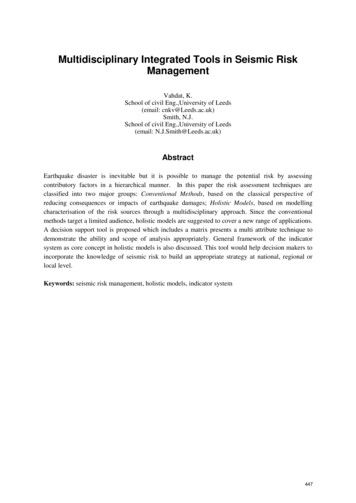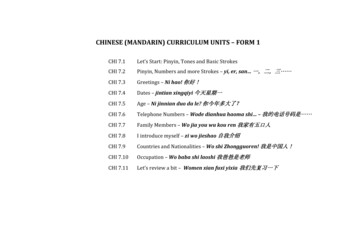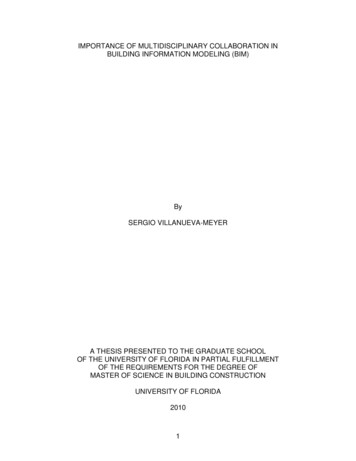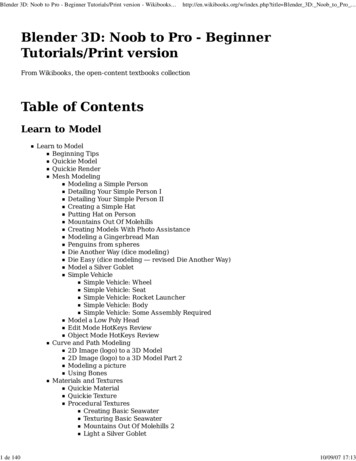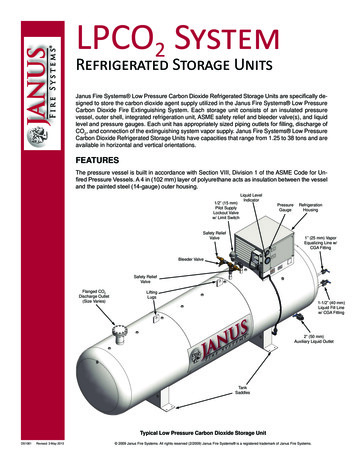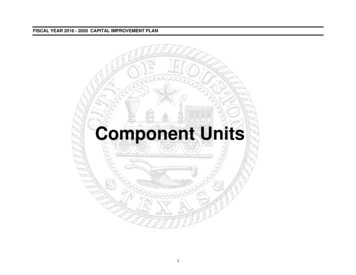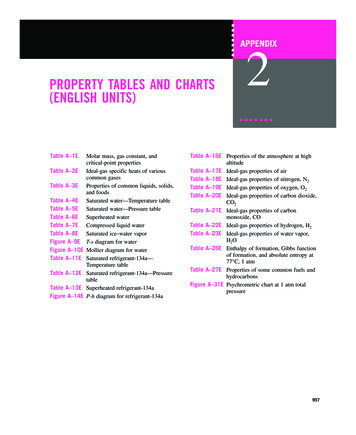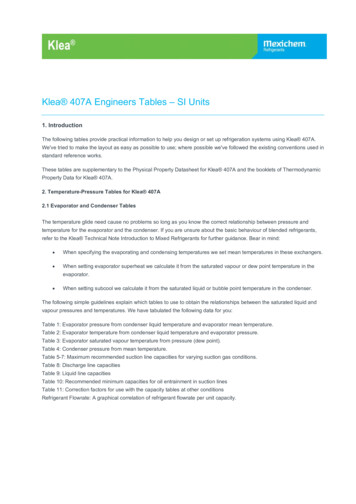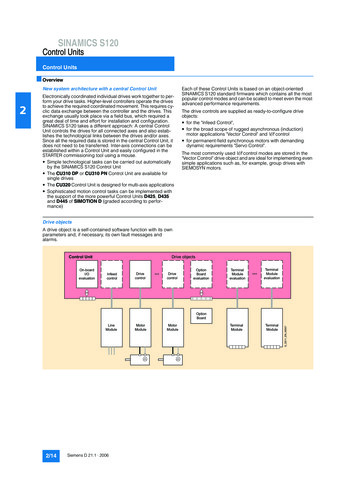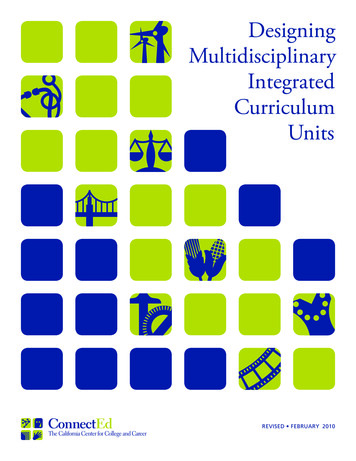
Transcription
sREVISED FEBRUARY 2010
AcknowledgmentsThe authors want to thank the many people whocontributed to this publication. Matt Perry, formerlyPrincipal of the Arthur A. Benjamin Health Professions High School (HPHS) in Sacramento,California, enthusiastically encouraged interdisciplinary curriculum integration throughout theschool and supported our creation of this manual.For five years, teachers at HPHS have used thisapproach to develop integrated curriculum unitsand have participated in exciting conversationsabout how to advance student learning. This manualreflects their dedication and hard work. BeverlyCampbell of BECGroup Consulting and the National Consortium on Health Science Education(NCHSE) carefully read the original manuscript andprovided helpful comments. She was instrumentalin guiding the successful curriculum integrationwork at HPHS. Carole Stacy, Executive Director ofNCHSE, provided support throughout the originalcurriculum development effort. We wish to extendour special thanks to Kathleen Harris, Director ofCoaching for ConnectEd, who helped us refine andexpand our work on curriculum mapping.We also want to acknowledge the contributions ofMPR Associates, Inc. staff to the production of thismanual: Barbara Kridl, Publishing Manager, andAndrea Livingston, Senior Editor, carefully read themanual, and Natesh Daniel, Senior PublishingAssociate, skillfully designed and produced the original version of the manual. Patti Gildersleeve, SeniorPublishing Associate, was responsible for producingthis updated version.Finally, we want to thank Gary Hoachlander,President of ConnectEd: The California Center forCollege and Career, and Anne Stanton, ProgramDirector at the James Irvine Foundation, for theirongoing support and vision to improve students’education and career outcomes through careerfocused pathways that incorporate interdisciplinarycurriculum integration.
ContentsPageAcknowledgmentsiiWelcome!ivDesigning Multidisciplinary Integrated Curriculum Units1Multidisciplinary Integrated Curriculum Model7Major Steps to Design an Integrated Curriculum Unit81 Connect With Industry and Postsecondary Partners92 Create and Share Curriculum and Performance Maps113 Decide on the Topic of the Integrated Unit154 Craft the Essential Question185 Identify Key Questions196 Allocate Responsibilities227 Review and Revise the Instructional Sequence238 Set the Learning Scenario259 Establish Student Assessments2710 Write Lesson Plans3211 Evaluate the Unit36Integrated Unit Logistics38Integrated Unit Evaluations: Teacher, Student,and Industry/Postsecondary Partners39References40Appendices41Appendix 1: Integrated Curriculum Unit TemplateAppendix 2: Integrated Curriculum Unit SampleAppendix 3: Student Progress Map TemplateAppendix 4: Student Progress Map SampleAppendix 5: Project Evaluation CriteriaAppendix 6: Curriculum Integration Action PlanDesigning Multidisciplinary Integrated Curriculum Units PAGE iii
Welcome!We’re excited that you are incorporatingcurriculum integration into your schooland are using this manual to supportthe process. We designed this manualfor teachers who are new to curriculumintegration and for those who want toenhance their current practice. Presentedhere is a roadmap for committedteams of teachers to work together inplanning, developing, and implementinga multidisciplinary, career-focused,and integrated high school curriculum.We hope this manual will help you besuccessful.
Designing MultidisciplinaryIntegrated Curriculum UnitsIntroductionEngagement is one of the most important keys tostudents’ academic success. Every teacher knowsthat even teaching the right foundation skills is notenough to ensure that they will learn. Students needto be curious about new material, focused on whatthey are learning, and, of course, present in class.Why do so many students lack this high level ofengagement? Today’s high school students are demanding relevant coursework and they aren’t gettingit. Too often, by the time they reach high school,students have concluded that school has little connection to their current lives and even less to offer inpreparing them for the future.by linking rigorous academic content to students’personal lives and the community issues they careabout.One of the most powerful strategies teachers can useto make learning relevant is to place academics within the context of issues and problems from the worldof work. Across the country, teachers, school administrators, and parents have seen students changetheir attitudes about school when they are solvingexciting problems and working on projects that linktheir academic and technical courses to an authenticcareer-related theme.Contextual instruction has proven to be the most powerful as-Many teachers have experienced,pect of our small high school. Students believe in their lessonsfirst hand, the disaffection ofwhen every assignment adds meaning and creates understandhigh school students who haveing in all of their classes. I can speak for our school; we haveturned away from learning betruly made a difference in our students’ hope for success—theycause they don’t connect withschool. Survey data make afeel empowered to dig deep and ask questions, and they are enstrong case for the importance of thusiastic about sharing their research with the world.relevant coursework for students.Matt Perry, PrincipalIn a 2006 survey of more thanArthur A. Benjamin Health Professions High School3,000 at-risk, early high schoolSacramento, Californiastudents in California, morethan 80 percent revealed thatCurriculum Integration Requires a Newthey would study more and work harder in school ifInstructional Approachthey saw the relevance of their classes to their futureeducation and careers (Peter D. Hart Research AsCurriculum integration is taking hold in a widesociates 2006).variety of high school settings. In career-focusedpathways, new small high schools, career academies,Applied learning theory can help us understand howand even large traditional high schools, teachers areto reverse this situation. According to researchers,integrating academic and technical instruction bystudents are more motivated to learn when they needfocusing on career-related themes. They are workto acquire knowledge (to accomplish somethinging across the usual boundaries of academic andthey care about), when they are curious (about antechnical fields to make course material more engaginteresting and challenging problem), and when theing, encourage once reluctant learners to enroll andmaterial relates to their own lives (Svinicki 2002).succeed in higher-level academic courses, and giveAs teachers, we can create this kind of motivationDesigning Multidisciplinary Integrated Curriculum Units PAGE 1
students a running start at planning for college andtheir future careers.The term “integrated curriculum” has many different, sometimes conflicting, meanings to educators. In this manual, integrated curriculum refersto the materials and pedagogical strategies used bymultidisciplinary teams of teachers to organize theirinstruction so that students are encouraged to makemeaningful connections across subject areas. English, mathematics, science, social studies, arts, worldlanguage, physical education, and career technicalteachers can all collaborate to plan and present related lessons that center around a central, career–themed issue or problem.What does a new multidisciplinary, integrated curriculum look like? It looks like the real, thorny, andexciting problem solving that engages professionalsin their daily work lives. It brings authenticity tostudents’ schoolwork, homework, and work-basedlearning situations. For example, in their mathematics and health sciences classes, Arthur A. BenjaminHealth Professions High School students, in Sacramento, California, learn about the calculations thatinsurance underwriters make, while they ponder ahighly relevant question: how do high-risk lifestyledecisions and behaviors affect access to and premiums for health insurance? While the students addressthis important question, their Spanish class providesa venue for studying differences in mortality ratesand causes of death in many Spanish-speaking coun-tries and across ethnic groups in the United States.Spanish becomes an important tool for researchingand understanding national and cultural differencesin rates of illness and injury and causes of death.In another example, students in several states examine the connections among genetics, diet, andexercise to explore the rising rate of obesity. Insteadof solving the usual math problems, algebra studentsin New York, Texas, and Utah apply their knowledgeof algebraic equations in calculating their body massindex. They also debate the link between fast foodconsumption and the rise in obesity in their English,biology, Spanish, and health science courses. Thesesubjects take on new relevance when students seethat they are tools for addressing an important reallife issue.Integrating courses around career-related themes andmaking those themes relevant to teenagers—whilealso addressing state-mandated academic and technical content—requires a new model for designinginstruction. This practical manual shows you howto create exciting and challenging curriculum unitsfor high schools that use this integrated instructionalapproach.The Goals of a Multidisciplinary IntegratedCurriculumDelivering a standards-based multidisciplinary integrated curriculum is a strategy that addresses manyof our national, state, and local objectives aroundWhat is Curriculum Integration?CTE1. Instruction centers around a concept, issue, problem, topic,or experience in a career-themed context.Science2. Students explore a set of topics in several standards-basedRealWorldIssueacademic disciplines connected by a unifying concept thatreinforces learning and brings the curriculum to life.3. The concept that is being explored brings together variousMathSocialStudiesaspects of the curriculum in a meaningful way.Designing Multidisciplinary Integrated Curriculum Units PAGE 2ELAWorldLang
high school improvement. This approach is designed to reach high school students at all academicachievement levels, to facilitate learning for studentswith diverse learning styles, to replace academictracking with placement based on students’ interests,and to close the achievement gaps across groups ofstudents. By focusing on mastering standards intechnical and core classes, students can apply whatthey have learned and, therefore, remember more ofit. Teachers, principals, and school district administrators who support this approach indicate that theyhave used it to accomplish the following: Shift classroom instruction from passive to active, thereby engaging more students in learning.Students become the center of the learning experience by collaborating in real-life, career-focusedprojects and problems that are connected to theircurrent interests and future pursuits. The work isteacher-directed, not teacher-centered. Provide students with knowledge of a wide varietyof career-related fields by creating research opportunities and career connections with professionalsin many jobs within a career area. Build community support for improving highschools through partnerships with industry,postsecondary education, and local communityrepresentatives. By engaging key industry, education, and community-based stakeholders in theirlocal communities, these educators are creatingsupport for schools and proactive education improvement policies and are providing future employment opportunities for their students.The Foundation of MultidisciplinaryIntegrated Curriculum Units Cohort scheduling of students Teacher professional development Identify the specific skills and lessons that studentsare not mastering by having administrators andteachers review the test data. Then teachers canincorporate those skills into the projects for additional student reinforcement. Standards-based, college-preparatory academiccourses Help students develop effective education andcareer planning skills. By participating in professional work and engaging with employees whoaddress exciting and challenging problems in theirjobs, students can recognize the need to performwell in high school, understand the educationalpathways leading to a variety of rewarding careers,and pursue postsecondary education and/or training to achieve their personal career goals. Academic supports for struggling students Reach out to the diverse group of students whocome to class with widely different backgroundsand levels of academic preparation. Students whoparticipate in an integrated curriculum can expresstheir own interests, demonstrate their unique skills,and master high-level academic and technical material by applying a variety of learning styles. Challenging career-technical courses Supportive counselorsTeachers are the key to success in creating a multidisciplinary integrated curriculum, but they can’t doit alone. Effective curriculum integration requires aninfrastructure that is different from that found in theusual high school. Major pieces of this infrastructureinclude supportive administrators, class schedulesthat facilitate teacher collaboration, investments infinding and working with industry and postsecondary partners outside the high school and the district,sustained teacher enthusiasm and commitment, anda foundation of solid integrated curriculum material.Success also requires a clear road map. This practicalmanual offers teachers that road map.Rest easy—designing a multidisciplinary integratedcurriculum does not require creating an entirely newset of academic courses. This manual presents a strategy for teams of teachers to enhance their academicDesigning Multidisciplinary Integrated Curriculum Units PAGE 3
and technical instruction by introducing multidisciplinary curriculum units into existing courses.Why Invest the Time to Create and UseIntegrated Curriculum Units?These integrated curriculum units are relativelylarge multidisciplinary projects that bring togetheracademic and technical subject material around acommon career- or industry-related issue or theme.Through immersion in an important problem facedby industry professionals, students experience theirstudies as more coherent and see how they connectwith the real world. An effective integrated unit improves instruction because it helps teachers addressimportant academic and technical standards in a newway. It arises out of students’ needs and interests, provides real-world relevance and application, and prepares students for success in college and career.For both teachers and students, incorporating integrated, career-themed curriculum units into a highschool program offers a variety of potential benefits.Lipson et al. (1993) examined research on integratedcurricula and student learning and described the following links between integrated curricula and positive student outcomes (cited in Lake 1994):Creating a successful interdisciplinary integrated curriculum starts with this short list of basic principles(the six A’s) identified by Adria Steinberg (1997). Integrated curricula encourage depth and breadthin learning.Academic andTechnical RigorAuthenticityAppliedLearning Integrated curricula help students apply skills. An integrated knowledge base leads to faster retrieval of information. Multiple perspectives lead to a more integratedknowledge actices Academic and Technical Rigor - Projects are designed to address key learning standards identifiedby the school or district. Active Exploration - Projects extend beyond theclassroom by connecting to internships, fieldbased investigations, and community explorations. Authenticity - Projects use a real world context(e.g., community and workplace problems) andaddress issues that matter to the students. Adult Connections - Projects connect studentswith adult mentors and coaches from the widercommunity. Applied Learning - Projects engage students insolving problems calling for competencies expected in high-performance work organizations (e.g.,teamwork, problem-solving, communication, etc.). Assessment Practices - Projects involve studentsin regular, performance-based exhibitions andassessments of their work; evaluation criteria reflect personal, school, and real-world standards ofperformance.Designing Multidisciplinary Integrated Curriculum Units PAGE 4
Integrated curricula promote positive attitudes instudents.In addition to these direct positive effects for students, there are also several benefits for teachers whocollaborate to create integrated curriculum units andlessons. Designing and delivering a multidisciplinaryintegrated curriculum helps teachers engage in and establish a culture ofprofessional dialogue about student work; offers a way to address and reinforce key stateacademic and technical standards through applications that are more interesting and engaging tostudents; provides fertile ground for high-quality studentprojects and presentations that encourage studentsto develop both academic and technical skills;Our work with students also suggests that engaging them in projects and having them investigateauthentic problems from the world of work acrossseveral courses helps them make connections across academicdisciplines; demonstrates the need to apply learning from several disciplines to solve real-world problems; introduces students to a wide range of career options and opportunities; connects students and their work to the largercommunity; and provides a better answer to the age-old question“why do I have to learn this?” than “because youneed it to graduate or to go to college.” establishes a meaningful vehicle for making connections across academic disciplines;What Does It Take to Build a SuccessfulMultidisciplinary Integrated Unit? encourages both teacher and student team building across technical and core departments andclasses, which deepens camaraderie, and bonding;Creating a multidisciplinary integrated curriculumunit requires a true partnership. School leaders,teachers, students, and industry and postsecondarypartners all play key roles in the curriculum designprocess. What exactly is needed from all of thesepartners? facilitates teacher collaboration, thus, reducingteacher “burn out”; reduces classroom discipline problems becauseteachers from core and technical classes meet regularly to discuss students’ performance, thereby allowing teachers to get to know individual studentsbetter; encourages higher expectations and student performance levels because industry partners participate in the classroom and judge the CulminatingEvent; fosters professional growth by encouraging teachers to go beyond the boundaries of their academicand technical fields; and brings coherence to the curriculum by providing athematic focus for a school program, a small learning community, or a classroom.From the school: A common intellectual mission and commitmentto high achievement for all students Agreement to implement a common curricularfocus that will cut across disciplines A flexible schedule that allows integrated, multidisciplinary project work and involvement withthe world beyond school Common planning time allotted for teachers toformulate and coordinate the components of anintegrated unit A funding model that supports the extra time,energy, and materials spent on developing andimplementing the integrated unitsDesigning Multidisciplinary Integrated Curriculum Units PAGE 5
Master scheduling priorities that lead to cohortsof students being placed in the same technical andcore academic classes Assistance and engagement with the goals and activities of the Advisory BoardFrom the teachers: Commitment and dedication to the common mission and focus Cooperation and teamwork among faculty andparticipating staff Shared responsibility in developing and implementing all aspects of the integrated units Agreement on core learning goals Agreement to build learning goals for the integrated curriculum unit by aligning it with existingacademic and technical content standards Risk taking and flexibility Focus on deeper structures and understandings oftheir discipline Encouragement of student ownership A love of learning and understanding that teachersneed to deepen their understanding and knowledge of the technical class and industry standards,professions, and practices Assistance in developing the Advisory Board andmaking it sustainableFrom the students: Commitment and dedication to the common mission and focus Cooperation and teamwork with other students,faculty, and participating staff Shared responsibility throughout the entire process of designing the integrated unit, includingactive participation in the Culminating Event Willingness to synthesize complex concepts intoa cohesive whole and to engage with communityand industry partners in the learning and assessment processesFrom industry and postsecondary partners: Showing commitment and dedication to the common mission and focus Volunteering as guest speakers for topics that relate to the thematic unit Serving on and assisting with the development ofthe Advisory Board Supporting students in their research and projectwork Providing opportunities for field trips and jobshadowing “Teaching the teachers” about industry standards,professions, practices, and issues Investing in the students by assessing their ongoing work, offering feedback, and evaluating theirculminating projects Offering feedback to teachers on curriculum development and related activities and collaboratingwith teachers as they develop the integrated units Offering feedback to students regarding the accuracy and relevance of material presented in theirprojects Volunteering facilities as venues for showcasingstudents’ work outside of class Providing student internships Introducing other industry partners to volunteeropportunities within the school Providing opportunities for summer teacher externships and other professional development tohelp teachers learn about authentic industry issues Willingness to pursue a deeper understanding ofthe material and its connections across disciplinesDesigning Multidisciplinary Integrated Curriculum Units PAGE 6
Multidisciplinary IntegratedCurriculum ModelIn the remainder of this manual, we offer detailson the major steps that teachers at 11 high schoolsacross the United States have followed to designand deliver multidisciplinary integrated curriculumunits. At a number of the high schools, teacherteams have tailored some of the steps to meet theirunique needs, but all of them have followed thebroad outlines of this model.Standards-based Curriculum and Performance MappingOverarching Industry Topic or sential QuestionKey questionSubquestionLessonactivityKey y ivityLessonactivityLessonactivityCulminating ProjectDesigning Multidisciplinary Integrated Curriculum Units PAGE 7Industrypartnersadvise andcollaboratewithstudentsIndustryevaluates
Major Steps to Design anIntegrated Curriculum Unitl 1 Connect With Industry and Postsecondary PartnersPlan to consult with industry and postsecondary partners for help with identifying authentic connections, providing specialized instruction and mentoring, and evaluating student work.l2 Creating and Sharing Curriculum and Performance MapsExamine the existing scope and sequence of concurrent academic and CTE classes, then map out andshare the performance measures for each class.l 3 Decide on the Topic of the Integrated UnitLook across the performance measures to find connections between classes and then choose a topic ofinterest to students that allows for authentic integration of multiple subject areas.l4 Craft the Essential QuestionSet up a need-to-know learning opportunity for students by framing the unit and driving the instruction with an essential question.l 5 Identify Key QuestionsBreak down the overall concept of the essential question into smaller parts, often directly related toindividual academic or CTE subjects.l6 Allocate ResponsibilitiesIdentify and assign the roles and responsibilities for each team member, particularly the team leader,to ensure that development and enactment of the integrated unit moves forward.l 7 Review and Revise the Instructional SequenceOnce the unit theme and general content has been chosen, revisit the curriculum map to identify potential sequence adjustments that might bring relevant topics closer together in the school year.l8 Set the Learning ScenarioPlan to engage student interest by introducing the unit with an interesting example of the unit themein a real-world setting, ideally with relevance to students’ lives.l 9 Establish Student AssessmentsDetermine appropriate formative and summative student assessments, including the culminatingproject. Ideally, the culminating project would allow students to demonstrate multidisciplinary content knowledge mastery.l 10 Write Lesson PlansAfter initial overall unit planning is complete, individual subject lesson plans and instructional materials should be written and/or assembled for enactment and future reference.l 11 Evaluate the UnitOnce the various pieces are finished, step back and re-evaluate the unit as a whole.Designing Multidisciplinary Integrated Curriculum Units PAGE 8
Connect With Industry andPostsecondary PartnersSTEP 1The first step in creating integrated curriculum unitsis to get to know your local industry or postsecondary partners. Partners are invaluable in helping toidentify authentic applications for academic andtechnical course content, evaluate the quality of student work, and build students’ education and careerplanning skills. Invite them to meet your teachersand students. The Work-Based Learning Coordinator, lead teacher, or another individual should beresponsible for connecting with partners outside theschool. This will ensure that there is one point ofcontact between the school and industry or postsecondary partners.The following are major Coordinator responsibilities: Identify community resources, such as local industry professionals, businesses, educators, organizations, or libraries, that can assist students in theirresearch and project work. Invite community/industry partners into the classroom for guest-speaking opportunities or teamteaching activities that relate to the integratedunit. These speakers can “teach the teachers” about industry practices,projects, standards, and professions; brainstorm about integrated curriculum unitprojects and provide authentic props, templates, and tools; personalize the topic of the integrated curriculum unit and provide additional local context; discuss how knowledge and skills from specificacademic disciplines are used in the workplace(e.g., “In our department we use algebra, statistics, or persuasive writing to ”); describe how they contribute to solving realworld problems in their jobs and the kinds ofteamwork, communication, and problem-solving skills that are needed to do this work; or provide information about the range of specificjobs and careers within their field and the kindsand levels of education and experience required. Assemble an “expert panel” of local professionalswith experience related to the unit topic. Ask panelists to assist in assessing and evaluating studentwork. Establish a network of community partners, including colleagues from other schools, colleges,and universities, who can offer feedback on curriculum development and other activities. Thisexpert panel can work as a steering committee oradvisory board for your school or academy, helping to establish internships and do curriculum development, marketing, and fundraising. For moreinformation, go to t/index.html. Invite the professionals to review drafts of studentwork, mentor students, provide feedback online,and judge final work products. Work with local colleges and universities to exposestudents to college students and professors andopportunities for taking college classes in highschool. Schedule visits to various local work sites, thusconnecting students to the world of work. Individuals at these sites should be prepared tospeak about how their organizations can provide connections to the curriculum topic and toimportant academic and technical standards. Individually or in small groups, students can“job shadow” professionals at these sites for aday to understand how the technical skills theyare learning relate to work.Students must also have a comprehensive and effective work-based learning experience that matcheswhat they are learning in the classroom. This expo-Designing Multidisciplinary Integrated Curriculum Units PAGE 9
sure helps sharpen students’ desire to increase theirknowledge and develop skills that are relevant totheir career interests. These work-based learning opportunities can take several forms: job shadowing,intensive internships, virtual apprenticeships, andschool-based enterprises. Ideally, this work-basedlearning is incorporated into students’ sequentialtechnical program of study. Possible models includeguest speakers and field trips in 9th grade, mentoring in 10th grade, job shadowing in 11th grade, andinternships in 12th grade.Multiple Roles for Industry and Postsecondary Partners in an Integrated Forensics UnitForensicsinstruction byfingerprintingexpertCurriculumDevelopmentCrime SceneInvestigation lawenforcementofficerInstruction andImplementationRole-playing withlegal professionalsin a cour
Campbell of BECGroup Consulting and the Na-tional Consortium on Health Science Education . amine the connections among genetics, diet, and exercise to explore the rising rate of obesity. Instead . teachers can
